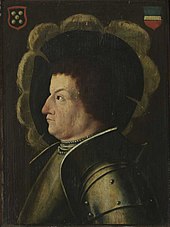Sickingen Heights

The Sickingen Heights (
Geography
Location
The Sickingen Heights form the northern part of the
Geology
The Sickingen Heights belong to the major region known as the Palatine-Saarland Muschelkalk Region (Pfälzisch-Saarländisches Muschelkalkgebiet).
Rivers and streams
Much of the Sickingen Heights is drained southwards by the Moosalb, Wallhalb and Auerbach into the Schwarzbach and then via the Blies, Saar and Moselle into the Rhine. The Lambsbach flows westwards directly into the Blies.
Sights and culture
- In the old schoolhouse at Queidersbach, built in 1836, is the Sickingen Heights Museum (Museum Sickinger Höhe). Opened in 1976 and covering an area of 500 m2, the museum offers an overview of history of the region from early times until the recent past.[2]
- In 1869, the Winterbach–Krähenberg–Kleinbundenbach–Großbundenbach–Zweibrücken) has been established as a themed walk.[5]
- In Wallhaben collective municipality hosts the Sickingen Dialect Poetry Competition (Sickinger Mundartdichter-Wettstreit).[6]
Settlement and transportation
The land is sparsely settled and the only large towns occur on the lower-lying perimeter of the plateau. There are no pan-regional transport routes, except for a mostly two-lane section of the A 62 motorway Landstuhl–Pirmasens.
Due to its remoteness, the region is well suited for hiking e.g. along the Mill Trail in the Wallhalb Valley. Over the Sickingen Heights runs the waymarked
References
- ^ naturschutz.rlp.de. "Landschaftsräume in Rheinland-Pfalz – Sickinger Höhe" (in German). Retrieved 2013-09-20.
- ^ Ortsgemeinde Queidersbach. "Museum Sickinger Höhe Queidersbach" (in German). Retrieved 2013-09-20.
- ^ Pfälzischer Merkur: "Der große Knall bleibt unvergessen" (pdf; 947 kB) (in German). 20 July 2009. Retrieved 2010-03-02.
- ^ "Der Knall aus dem All", Die Rheinpfalz Am Sonntag (in German), Ludwigshafen, 28 February 2010
- Landkreis Südwestpfalz, ILE: "Teilprojekt Wander- und Radwanderland Sickinger Höhe" (in German). January 2009. Archived from the originalon 2015-09-24. Retrieved 2010-03-02.
- ^ Verbandsgemeinde Wallhalben. "Mundart" (in German). Retrieved 2013-09-20. Menüpunkt "Mundart"
